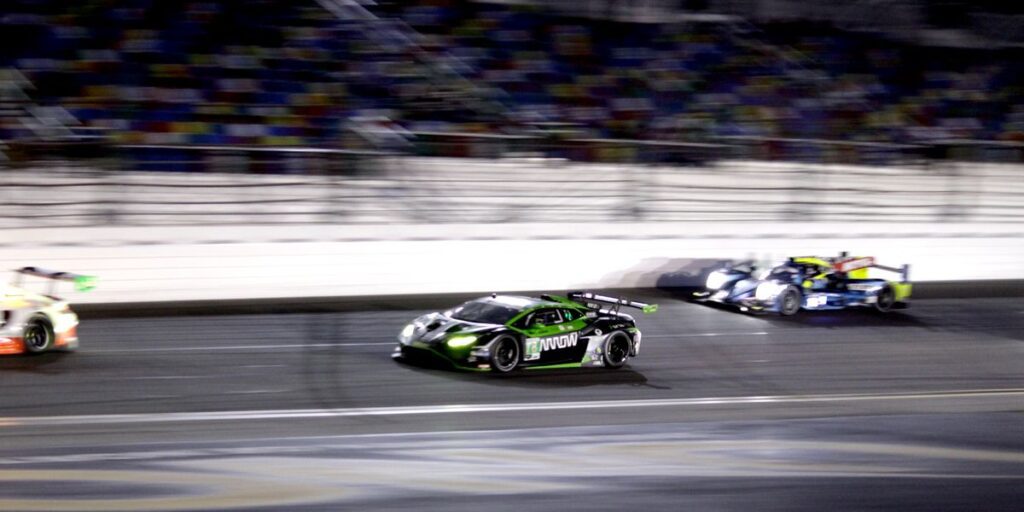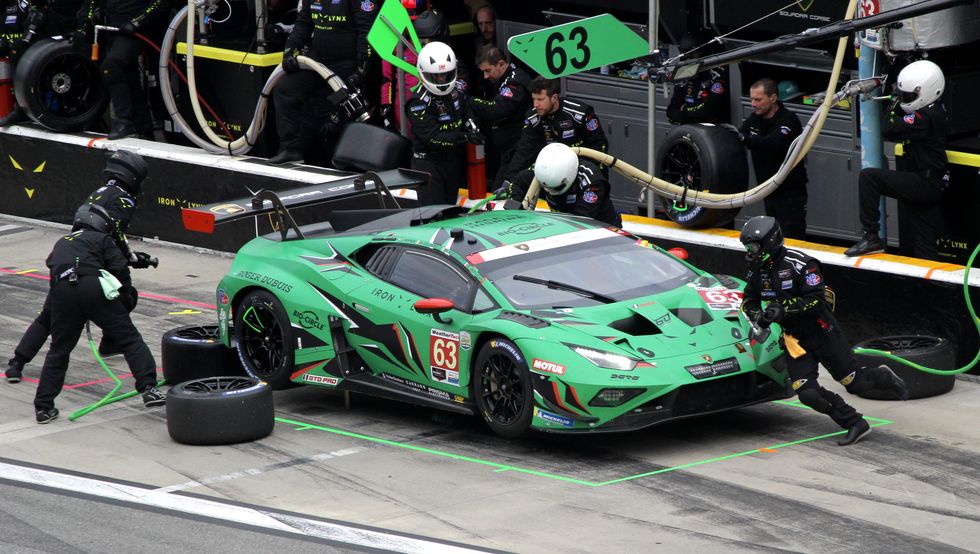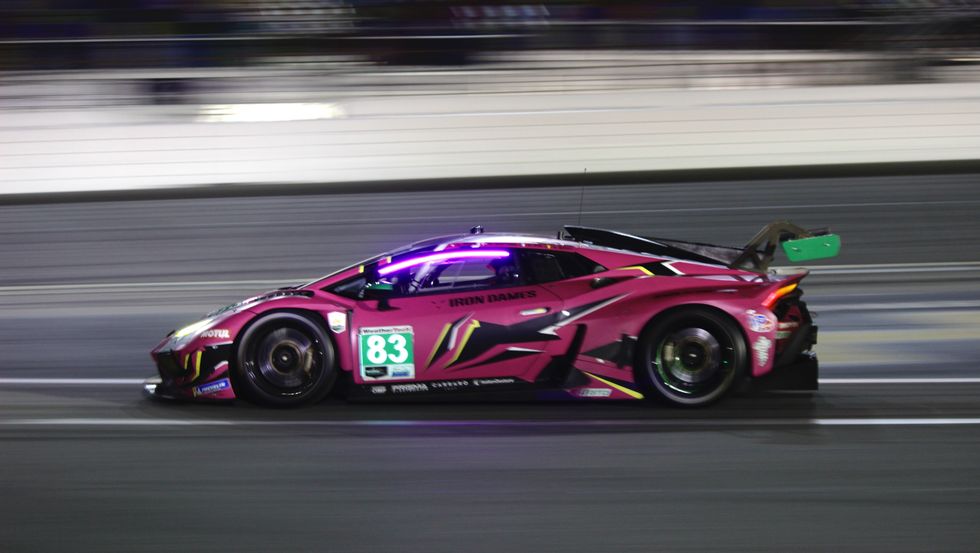Lamborghini Eyes Daytona Victory as It Begins Transition into Hybrids

Since the start of the Super Trofeo series in 2009, Lamborghini has become increasingly involved in motorsports, and next year will enter the top class of endurance racing.That hybrid LMDh (which stands for Le Mans Daytona hybrid) car will pair a twin-turbo V-8 with an electric powertrain, with development occurring alongside the company’s upcoming roadgoing hybrid supercars.Racing has also been key for Lamborghini when tuning the handling of its lineup, and it has helped expand the reach of the brand and solidify its reputation for honed track machines.
Among the 61 race cars rocketing past the green flag to start the 2023 24 Hours of Daytona last Saturday were five Lamborghini Huracán GT3 Evo 2 cars. Over the day-long competition, six Lamborghini factory drivers slotted behind the wheel, with the automaker’s Squadra Corse motorsport division providing trackside support.
Racing wasn’t always Lamborghini’s realm. When Ferruccio Lamborghini founded his namesake company in 1963, he focused solely on road cars. He had found Ferraris of the era rough and unrefined, labeling them glorified track cars, and he vowed to build the best roadgoing sports cars. So while Ferrari’s journey started with motorsports—with Enzo Ferrari only developing road cars to fund his racing efforts—Lamborghini eschewed the track in his pursuit of on-road driving manners and interior quality.
The ensuing decades saw Lamborghini occasionally dabble in racing; there was a failed venture as a Formula 1 engine supplier in the early ’90s and limited involvement in GT racing with the Diablo and Murciélago. But since launching the one-make Super Trofeo series in 2009, Lamborghini has caught the racing bug, and next year the company will join the top class of endurance racing with an LMDh prototype designed to conquer both Daytona and Le Mans. At a media roundtable at this year’s 24 Hours of Daytona, we spoke with CEO Stephan Winkelmann and chief technical officer Rouven Mohr about Lamborghini’s increased passion for motorsports and how it benefits the brand.
A teaser for the 2024 Lamborghini LMDh racer.
Lamborghini
Plug-In Hybrid Coming
“We think that times have changed,” explained Winkelmann, when asked about the expansion into prototype endurance racing. “For us, [LDMh] is the best opportunity to test materials, and the fact that it’s a hybrid is fitting perfectly in our strategy.”
Lamborghini is set to reveal its first plug-in hybrid this year as a successor to the Aventador. The new supercar will retain a V-12 engine, with Mohr emphatically declaring, “We are not following the downsizing trend.” A plug-in follow-up to the Huracán and an electrified Urus are also expected in the near future. Meanwhile, the LMDh race car that will take on the World Endurance Championship (WEC) and IMSA SportsCar Championship in 2024 will pair a twin-turbo V-8 with an electric powertrain.
While the LMDh setup is designed specifically for competition, knowledge from running the hybrid race car will eventually transfer back into roadgoing Lamborghinis. “But at the moment, it’s the opposite way around,” revealed Mohr. “We learned already a lot about the energy management for the street cars; we are not starting from zero in the LMDh.” Regardless of which direction the technology is flowing, the timing of the LMDh entry and Lamborghini’s push towards electrification is no coincidence and demonstrates the brand’s commitment to a transition to hybrids.

Caleb Miller|Car and Driver
Along with developing emerging tech, racing has been crucial for tuning the suspension and steering of the road-legal supercars. “If you want to improve the handling and the behavior of the car, motorsport is the perfect field to train,” Mohr said. He also explained that the motorsport department, Squadra Corse, and the company’s R&D division are closely linked, with employees switching between the two branches. This influence has led to more track-focused street cars, like the Huracán STO, basically a GT3 race car for the road, with wings and fins sprouting from its chiseled carbon-fiber bodywork. More track editions will evolve out of the upcoming hybrids, but Winkelmann wouldn’t divulge any details just yet.
Brand Building
Racing is about more than just boosting the performance of the Lamborghini lineup. As indicated by the hundreds of logos plastered across every race car on the Daytona grid, motorsport is just as much about marketing as it is about competition, and Lamborghini’s motorsports push has helped shift the brand’s image over the past decade.
“We started officially in motorsport with Super Trofeo because we thought we have to build a connection between us and our customers,” said Winkelmann. Super Trofeo, like the Ferrari Challenge series, is for so-called “gentleman drivers”—basically the ultra-wealthy who have some extra pocket change and want to live out their racing dreams. The series allows Lamborghini owners to experience the Huracán, and before it the Gallardo, in an environment where they could push the supercar to its limits and experience the extremes of its performance capability.

Caleb Miller|Car and Driver
In a way, the series serves as a way of training the company’s customers. “We use this also as a boost for the capability of our drivers,” Winkelmann said. Teaching Lamborghini owners how to handle such powerful machines through Super Trofeo extends beyond the track. “Most of them use Lamborghini cars every day.”
Super Trofeo has also increased awareness for the brand, expanding Lamborghini’s reputation beyond the company’s historically flashy design to solidify it as a maker of highly capable corner carvers. “We have so many followers, not only for the brand Lamborghini but also for Squadra Corse,” Winkelmann said. The Super Trofeo program also led Lamborghini to enter GT3 racing, the FIA-homologated class that races in WEC and IMSA. The Evo 2s taking part in the 2023 24 Hours of Daytona are the third generation of GT3 race cars that share a silhouette with license-plate-wearing Lamborghinis, furthering establishing the link between the brand’s products and track performance.
While some purists may be put off by the idea of Lamborghini shifting into hybrids, Lamborghini promises that the electrified supercars—and eventually the brand’s full EVs—will still bring the emotional connection that’s expected from a Lamborghini, the charisma that has been encapsulated by their designs and engines for decades. And we have a strong feeling that the automaker’s continued passion for motorsports and its new entry into LMDh will help ensure that the soul of Lamborghini remains alive and well in the electric age.




